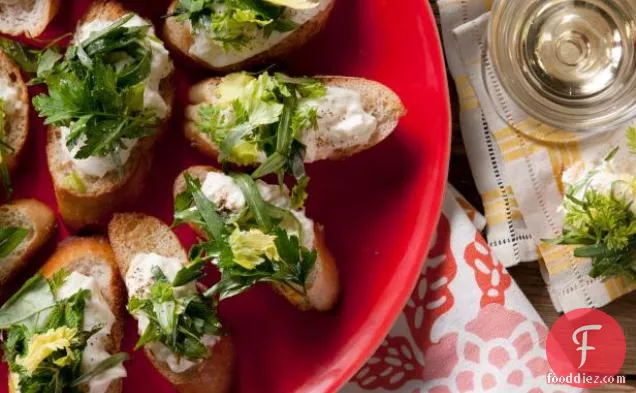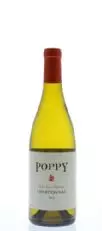Fresh Herb Salad with Burrata

Need a lacto ovo vegetarian hor d'oeuvre? Fresh Herb Salad with Burrata could be a spectacular recipe to try. This recipe serves 6. One portion of this dish contains approximately 9g of protein, 38g of fat, and a total of 382 calories. This recipe covers 13% of your daily requirements of vitamins and minerals. A mixture of mint leaves, chervil leaves, celery leaves, and a handful of other ingredients are all it takes to make this recipe so yummy. From preparation to the plate, this recipe takes around 25 minutes. If you like this recipe, you might also like recipes such as Fresh Peach, Basil and Burrata Salad, Herbed Potato Salad with Fresh Tomatoes and Burrata, and Fresh Herb Salad With Seeds.
Instructions
1
For the crostini:Preheat the oven to 400 degrees F.
Ingredients you will need![Crostini]() Crostini
Crostini
Equipment you will use![Oven]() Oven
Oven
2
Place the bread on a baking sheet in a single layer evenly spaced out.
Ingredients you will need![Bread]() Bread
Bread
Equipment you will use![Baking Sheet]() Baking Sheet
Baking Sheet
4
Bake until the bread is crisp, about 10 minutes. Halfway through baking, flip the crostini and toast the other side.
Ingredients you will need![Crostini]() Crostini
Crostini![Sandwich Bread]() Sandwich Bread
Sandwich Bread
Equipment you will use![Oven]() Oven
Oven
6
While the crostini is still warm, rub each slice of bread with the garlic and season with salt and pepper.
Ingredients you will need![Salt And Pepper]() Salt And Pepper
Salt And Pepper![Crostini]() Crostini
Crostini![Garlic]() Garlic
Garlic![Bread]() Bread
Bread![Dry Seasoning Rub]() Dry Seasoning Rub
Dry Seasoning Rub
7
For the herb salad:Make sure all of the herbs are washed and dried and place into a bowl.
Ingredients you will need![Herbs]() Herbs
Herbs
Equipment you will use![Bowl]() Bowl
Bowl
Ingredients
1large![baguette, cut on the bias into 1/2-inch thick slices]() baguette, cut on the bias into 1/2-inch thick slices227grams
baguette, cut on the bias into 1/2-inch thick slices227grams![burrata cheese]() burrata cheese118milliliters
burrata cheese118milliliters![fresh celery leaves]() fresh celery leaves118milliliters
fresh celery leaves118milliliters![fresh chervil leaves]() fresh chervil leaves118milliliters
fresh chervil leaves118milliliters![fresh basil leaves]() fresh basil leaves118milliliters
fresh basil leaves118milliliters![fresh mint leaves]() fresh mint leaves118milliliters
fresh mint leaves118milliliters![fresh parsley leaves]() fresh parsley leaves118milliliters
fresh parsley leaves118milliliters![fresh tarragon leaves]() fresh tarragon leaves1clove
fresh tarragon leaves1clove![garlic, peeled]() garlic, peeled1
garlic, peeled1![lemon, juiced]() lemon, juiced6servings
lemon, juiced6servings![Kosher salt and freshly cracked black pepper]() Kosher salt and freshly cracked black pepper6servings
Kosher salt and freshly cracked black pepper6servings![Extra-virgin olive oil]() Extra-virgin olive oil6servings
Extra-virgin olive oil6servings![Olive oil, for drizzling]() Olive oil, for drizzling
Olive oil, for drizzling
 baguette, cut on the bias into 1/2-inch thick slices227grams
baguette, cut on the bias into 1/2-inch thick slices227grams burrata cheese118milliliters
burrata cheese118milliliters fresh celery leaves118milliliters
fresh celery leaves118milliliters fresh chervil leaves118milliliters
fresh chervil leaves118milliliters fresh basil leaves118milliliters
fresh basil leaves118milliliters fresh mint leaves118milliliters
fresh mint leaves118milliliters fresh parsley leaves118milliliters
fresh parsley leaves118milliliters fresh tarragon leaves1clove
fresh tarragon leaves1clove garlic, peeled1
garlic, peeled1 lemon, juiced6servings
lemon, juiced6servings Kosher salt and freshly cracked black pepper6servings
Kosher salt and freshly cracked black pepper6servings Extra-virgin olive oil6servings
Extra-virgin olive oil6servings Olive oil, for drizzling
Olive oil, for drizzlingRecommended wine: Chardonnay, Sauvignon Blanc, Gruener Veltliner
Chardonnay, Sauvignon Blanc, and Gruener Veltliner are my top picks for Salad. Sauvignon Blanc and Gruner Veltliner both have herby notes that complement salads with enough acid to match tart vinaigrettes, while a Chardonnay can be a good pick for creamy salad dressings. One wine you could try is Poppy Santa Lucia Highlands Chardonnay. It has 4.7 out of 5 stars and a bottle costs about 16 dollars.

Poppy Santa Lucia Highlands Chardonnay
Youthful notes of lemon and honeysuckle are layered over ripe melon, nutmeg, and clove. The perception of sweetness is derived from fruit ripeness, aging on regularly stirred yeast lees in the presence of aged French Oak.DifficultyMedium
Ready In25 m.
Servings6
Health Score17
Related recipes
Warm Szechuan Shrimp and Spinach Salad
Pineapple Couscous Salad
Fruity Apple Salad
Red, White and Blue Slaw Salad
Magazine

Your Inner Chef with Taylor Swift's Top 3 Recipes from Her Beloved NYC Hangout

20 Mouthwatering Recipes You Need to Try Today!

Master the Art of Making Perfect Pancakes with This Foolproof Recipe

The Science Behind Red Wine: Its Surprising Health Benefits and Potential Risks

12 Wine Cocktails for a Sophisticated Twist

Sip, Swirl, and Celebrate: Toasting to National Wine Day on May 25th

National Drink Wine Day on February 18

Celebrating Souffle Day with Delectable Delights

Indulge in the Delightful Flavor of Oyster Soup on Its Special Day!

Celebrating World Nutella Day

Top 10 Global Food Trends of 2023

Transform Your Relationship With Food With These Must-Read Books

Indiana's Exciting Addition to the Summer Food Program for School Children

Art of Chimichurri: A Mouthwatering Recipe

Tantalize Your Taste Buds: the Finest Argentinian Restaurants in Los Angeles

Celebrating Argentina Independence Day - July 9, 2024

The Rainbow Theory of Food

Celebrating China's Independence Day with Flavorful Recipes

7 Indian Foods That Have Been Declared the Best in the World

3 Simple Tips to Cut Down on Ultra-Processed Foods, Recommended by a Skilled Nutritionist

Your Inner Chef with Taylor Swift's Top 3 Recipes from Her Beloved NYC Hangout

20 Mouthwatering Recipes You Need to Try Today!

12 Wine Cocktails for a Sophisticated Twist

Celebrating Souffle Day with Delectable Delights

Indulge in the Delightful Flavor of Oyster Soup on Its Special Day!

These Super Recipes for Your Football Party!

The Secrets Behind 3 Classic Comfort Food Recipes

Celebrate National Pizza Day on February 9th with Mouthwatering Slices and Fun Facts

Vegetarian soup recipes are not just for vegetarians anymore



